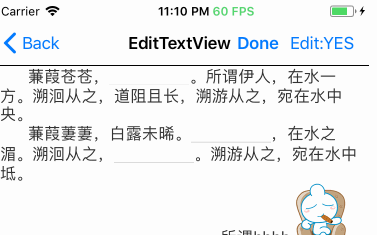ZIKRouter
An interface-oriented router for discovering modules and injecting dependencies with protocol.
The view router can perform all navigation types in UIKit through one method.
The service router can discover and prepare corresponding module with it's protocol.
Features
- [x] Swift, Objective-C and mixed development Support
- [x] Routing for UIViewController, UIView and any classes
- [x] Dependency injection
- [x] Locate view and service with it's protocol
- [x] Prepare the module with it's protocol when performing route, rather than passing a parameter dictionary
- [x] Use different protocols inside module and module's caller to get the same module, then the caller won't couple with any protocol
- [x] Declare routable protocol. There're compile-time checking and runtime checking to make safe routing
- [x] Declare a specific router with generic parameters
- [x] Decouple modules and add compatible interfaces with adapter
- [x] Encapsulate navigation methods in UIKit (push, present modally, present as popover, segue, show, showDetail, addChildViewController, addSubview) and custom transitions into one method
- [x] Remove a UIviewController/UIView or unload a module through one method, without using pop、dismiss、removeFromParentViewController、removeFromSuperview in different situation. Router can choose the proper method
- [x] Support storyboard. UIViewController and UIView from a segue can auto create it's registered router
- [x] Error checking for UIKit view transition
- [x] AOP for view transition
- [ ] Support Mac OS and tv OS
- [ ] Register router manually after launch, not just automatically registering all routers
- [ ] Add route for module with block, not just router subclasses
Sample
View Router
Demo view controller and protocol:
///Editor view's interface
protocol NoteEditorInput {
weak var delegate: EditorDelegate? { get set }
func constructForCreatingNewNote()
}
///Editor view controller
class NoteEditorViewController: UIViewController, NoteEditorInput {
...
}
Objective-C Sample
///editor view's interface
@protocol NoteEditorInput <ZIKViewRoutable>
@property (nonatomic, weak) id<EditorDelegate> delegate;
- (void)constructForCreatingNewNote;
@end
///Editor view controller
@interface NoteEditorViewController: UIViewController <NoteEditorInput>
@end
@implementation NoteEditorViewController
@end
Transition directly
Transition to editor view directly:
class TestViewController: UIViewController {
//Transition to editor view directly
func showEditorDirectly() {
Router.perform(to: RoutableView<NoteEditorInput>(), from: self, routeType: .push)
})
}
}
Objective-C Sample
@implementation TestViewController
- (void)showEditorDirectly {
//Transition to editor view directly
[ZIKViewRouterToView(NoteEditorInput) performFromSource:self routeType:ZIKViewRouteTypePush];
}
@end
You can change transition type with routeType:
enum ZIKViewRouteType : Int {
case push
case presentModally
case presentAsPopover
case performSegue
case show
case showDetail
case addAsChildViewController
case addAsSubview
case custom
case getDestination
}
Transition and Prepare
Transition to editor view, and prepare it before transition:
class TestViewController: UIViewController {
//Transition to editor view, and prepare the destination with NoteEditorInput
func showEditor() {
Router.perform(
to: RoutableView<NoteEditorInput>(),
from: self,
configuring: { (config, prepareDestination, _) in
//Route config
//Transition type
config.routeType = .push
config.routeCompletion = { destination in
//Transition is completed
}
config.errorHandler = { (action, error) in
//Transition failed
}
//Prepare the destination before transition
prepareDestination({ destination in
//destination is inferred as NoteEditorInput
destination.delegate = self
destination.constructForCreatingNewNote()
})
})
}
}
Objective-C Sample
@implementation TestViewController
- (void)showEditor {
//Transition to editor view, and prepare the destination with NoteEditorInput
[ZIKViewRouterToView(NoteEditorInput)
performFromSource:self
configuring:^(ZIKViewRouteConfig *config) {
//Route config
//Transition type
config.routeType = ZIKViewRouteTypePush;
//Prepare the destination before transition
config.prepareDestination = ^(id<NoteEditorInput> destination) {
destination.delegate = self;
[destination constructForCreatingNewNote];
};
config.routeCompletion = ^(id<NoteEditorInput> destination) {
//Transition is completed
};
config.performerErrorHandler = ^(SEL routeAction, NSError * error) {
//Transition failed
};
}];
}
@end
Remove
You can remove the view by removeRoute, without using pop / dismiss / removeFromParentViewController / removeFromSuperview:
class TestViewController: UIViewController {
var router: DestinationViewRouter<NoteEditorInput>?
func showEditor() {
//Hold the router
router = Router.perform(to: RoutableView<NoteEditorInput>(), from: self, routeType: .push)
})
}
func removeEditorDirectly() {
guard let router = router, router.canRemove else {
return
}
router.removeRoute()
router = nil
}
func removeEditorWithResult() {
guard let router = router, router.canRemove else {
return
}
router.removeRoute(successHandler: {
print("remove success")
}, errorHandler: { (action, error) in
print("remove failed, error:%@",error)
})
router = nil
}
func removeEditorAndPrepare() {
guard let router = router, router.canRemove else {
return
}
router.removeRoute(configuring: { (config, prepareDestination) in
config.animated = true
prepareDestination({ destination in
//Use destination before remove it
})
})
router = nil
}
}
Objective-C Sample
@interface TestViewController()
@property (nonatomic, strong) ZIKDestinationViewRouter(id<NoteEditorInput>) *router;
@end
@implementation TestViewController
- (void)showEditorDirectly {
//Hold the router
self.router = [ZIKViewRouterToView(NoteEditorInput)
performFromSource:self routeType:ZIKViewRouteTypePush];
}
- (void)removeEditorDirectly {
if (![self.router canRemove]) {
return;
}
[self.router removeRoute];
self.router = nil;
}
- (void)removeEditorWithResult {
if (![self.router canRemove]) {
return;
}
[self.router removeRouteWithSuccessHandler:^{
NSLog(@"pop success");
} errorHandler:^(ZIKRouteAction routeAction, NSError *error) {
NSLog(@"pop failed,error:%@",error);
}];
self.router = nil;
}
- (void)removeEditorAndPrepare {
if (![self.router canRemove]) {
return;
}
[self.router removeRouteWithConfiguring:^(ZIKViewRemoveConfiguration *config) {
config.animated = YES;
config.prepareDestination = ^(UIViewController<NoteEditorInput> *destination) {
//Use destination before remove it
};
}];
self.router = nil;
}
@end
Service Router
Get a module and use:
///time service's interface
protocol TimeServiceInput {
func currentTimeString() -> String
}
class TestViewController: UIViewController {
@IBOutlet weak var timeLabel: UILabel!
func callTimeService() {
//Get the service for TimeServiceInput
let timeService = Router.makeDestination(
to: RoutableService<TimeServiceInput>(),
preparation: { destination in
//prepare the service if needed
})
//Use the service
timeLabel.text = timeService.currentTimeString()
}
}
Objective-C Sample
///time service's interface
@protocol TimeServiceInput <ZIKServiceRoutable>
- (NSString *)currentTimeString;
@end
@interface TestViewController ()
@property (weak, nonatomic) IBOutlet UILabel *timeLabel;
@end
@implementation TestViewController
- (void)callTimeService {
//Get the service for TimeServiceInput
id<TimeServiceInput> timeService = [ZIKServiceRouterToService(TimeServiceInput) makeDestination];
self.timeLabel.text = [timeService currentTimeString];
}
Demo and Practice
ZIKRouter is designed for VIPER architecture at first. But you can also use it in MVC or anywhere.
The demo (ZIKRouterDemo) in this repository shows how to use ZIKRouter to perform each route type.
If you want to see how it works in a VIPER architecture app, go to ZIKViper.
Installation
Cocoapods
For Objective-C project:
pod 'ZIKRouter', '0.13.0'
For Swift project:
pod 'ZRouter', '0.9.0'
How to use
Quick start to use ZIKRouter.
1.Create Router
Create router subclass for your module:
import ZIKRouter.Internal
import ZRouter
class NoteEditorViewRouter: ZIKViewRouter<NoteEditorViewController, ViewRouteConfig> {
override class func registerRoutableDestination() {
registerView(NoteEditorViewController.self)
register(RoutableView<NoteEditorInput>())
}
override func destination(with configuration: ViewRouteConfig) -> NoteEditorViewController? {
let destination: SwiftSampleViewController? = ... ///instantiate your view controller
return destination
}
override func prepareDestination(_ destination: NoteEditorViewController, configuration: ViewRouteConfig) {
//Inject dependencies to destination
}
}
Objective-C Sample
//NoteEditorViewRouter.h
@import ZIKRouter;
@interface NoteEditorViewRouter : ZIKViewRouter
@end
//NoteEditorViewRouter.m
@import ZIKRouter.Internal;
@implementation NoteEditorViewRouter
+ (void)registerRoutableDestination {
[self registerView:[NoteEditorViewRouter class]];
[self registerViewProtocol:ZIKRoutableProtocol(NoteEditorInput)];
}
- (NoteEditorViewRouter *)destinationWithConfiguration:(ZIKViewRouteConfiguration *)configuration {
NoteEditorViewRouter *destination = ... ///instantiate your view controller
return destination;
}
- (void)prepareDestination:(NoteEditorViewRouter *)destination configuration:(ZIKViewRouteConfiguration *)configuration {
//Inject dependencies to destination
}
@end
Read the documentation for more details and more methods to override.
2.Declare Routable Type
//Declare NoteEditorViewController is routable
extension NoteEditorViewController: ZIKRoutableView {
}
//Declare NoteEditorInput is routable
extension RoutableView where Protocol == NoteEditorInput {
init() { }
}
Objective-C Sample
//Declare NoteEditorViewController is routable
DeclareRoutableView(NoteEditorViewController, NoteEditorViewRouter)
///If the protocol inherits from ZIKViewRoutable, it's routable
@protocol NoteEditorInput <ZIKViewRoutable>
@property (nonatomic, weak) id<EditorDelegate> delegate;
- (void)constructForCreatingNewNote;
@end
3.Use
class TestViewController: UIViewController {
//Transition to editor view directly
func showEditorDirectly() {
Router.perform(to: RoutableView<NoteEditorInput>(), from: self, routeType: .push)
})
}
//Transition to editor view, and prepare the destination with NoteEditorInput
func showEditor() {
Router.perform(
to: RoutableView<NoteEditorInput>(),
from: self,
configuring: { (config, prepareDestination, _) in
config.routeType = .push
//Prepare the destination before transition
prepareDestination({ destination in
//destination is inferred as NoteEditorInput
destination.delegate = self
destination.constructForCreatingNewNote()
})
})
}
}
Objective-C Sample
@implementation TestViewController
//Transition to editor view directly
- (void)showEditorDirectly {
//Transition to editor view directly
[ZIKViewRouterToView(NoteEditorInput) performFromSource:self routeType:ZIKViewRouteTypePush];
}
//Transition to editor view, and prepare the destination with NoteEditorInput
- (void)showEditor {
[ZIKViewRouterToView(NoteEditorInput)
performFromSource:self
configuring:^(ZIKViewRouteConfig *config) {
config.routeType = ZIKViewRouteTypePush;
//Prepare the destination before transition
config.prepareDestination = ^(id<NoteEditorInput> destination) {
destination.delegate = self;
[destination constructForCreatingNewNote];
};
}];
}
@end


